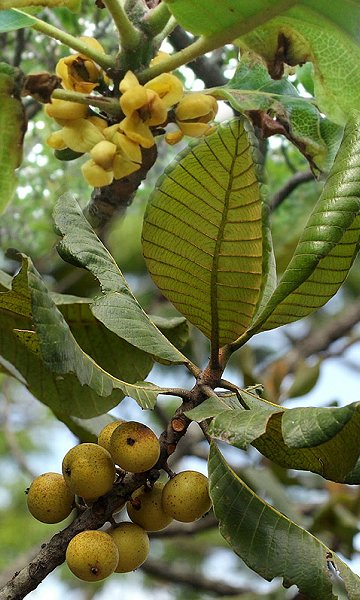
|
|
Wild Loquat - Sugar Plum
(Uapaca kirkianaa). Flowers and fruits.
|
Wild Loquat - Sugar Plum - Uapaca kirkiana
Uapaca kirkiana, the sugar plum or Wild Loquat
or mahobohobo, is a species of dioecious plant in the family Phyllanthaceae. It is native to the southern Afrotropics, where it occurs in well-watered miombo woodlands. Within range it is one of the most popular wild fruits. It is rarely cultivated but trees are left when land is being cleared. Still a traditional food plant in Africa, this little-known fruit has the potential to improve nutrition, boost food security, foster rural development and support sustainable land
care.
Uapaca kirkiana is a tropical small tree. It grows to a height of 5–13 meters, and 15–25 cm in trunk
diamete, with a rounded crown and dark gray, rough bark. It can be evergreen or semi-deciduous. The branches are multiple and spreading and the bole is short and stout. The leaves are leathery, oval, and scattered or clustered at terminal branches. The dark green, glossy leaves are 12–36 cm long and 8–24 cm wide.
It is a dioecious species – the clusters of staminate (or male) and single pistillate (or female) flowers are borne on separate trees. The flowers are greenish-yellow. The fruits are round and rusty-yellow.
It is not prone to attack by pests. It grows in areas with over 600mm/year of rain, and prefers well drained sand or gravelly soils low in organic matter; its presence is indicative of poor agricultural soils.
It occurs in the miombo woodlands of Angola, the DRCongo, Zambia, southern Burundi, Tanzania, Malawi, central and northern Mozambique, and
Zimbabwe.
Female trees fruit after about 9–10 years from seed. The fruit is roughly spherical drupe about 2–4 cm in diameter, green in colour ripening to yellow or brown. When ripe, the 1.5mm hard shell encloses the yellow flesh which has an appealing sweet taste that has been likened to pear or plum. Fruits usually contain 3 or 4 seeds, though sometimes 5. Fruits weigh between 5 and 50 grams each, with from 0.2-30 grams of pulp. The fruit is usually eaten by wild animals such as monkeys.
The fruits can be eaten raw or cooked. Fleshy and sweet, it has a delicious flavour. The fruit is commonly eaten fresh and is highly regarded. It can also be used for brewing a very pleasant wine or for making cakes that are fried and eaten. The juice of the fruit is mixed with sorghum meal to form a thin, orange-flavoured porridge. The fruit pulp is juicy, honey-like, very tasty and somewhat reminiscent of pears. Dried fruits have a toffee-like flavour[301 ]. The fruit is about 4cm x 4cm.
Root infusion is used in the treatment of indigestion and dysentery.
The tree is planted for soil erosion control, as a shade tree, and as an ornamental. The roots yield blue dye and the leaves are used as a cockroach repellent. The wood, being hard, durable and resistant to termite attacks, is ideal for general carpentry, furniture, house building, carvings and boxes, and many others. If not for the said uses, it is used as fuel and for making charcoal.
Source:
https://en.wikipedia.org/wiki/Uapaca_kirkiana
https://pfaf.org/user/Plant.aspx?LatinName=Uapaca+kirkiana
